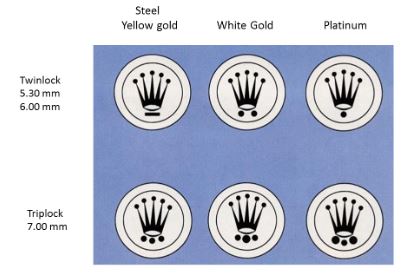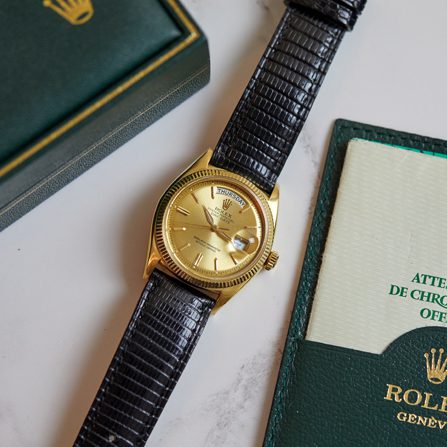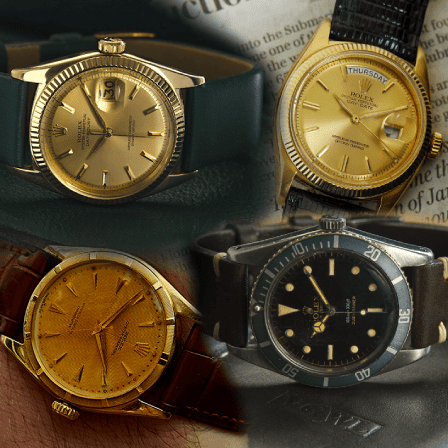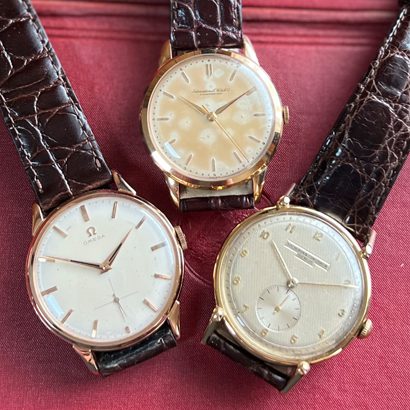HOW TO SPOT
A FAKE VINTAGE ROLEX
Rolex, commercially, is the no.1 watch brand in the world. This makes it the no.1 target for counterfeiters. Watches, by value, are the most copied commodity on Earth and Rolex is by far the most frequently faked brand. Their designs are distinctive and most of their watches are simple in function. In addition, the fact that Rolex watches evolve slowly with small incremental changes, gives counterfeiters the opportunity to refine their copies.
This creates a significant risk for anyone buying a pre-owned or vintage Rolex. You would not want to lose your money by purchasing a worthless forgery by mistake. Fortunately, this guide tells you how to spot a fake vintage Rolex so you can identify the key details that forgers get wrong and keep yourself safe.

Lever The Knowledge Of An Expert
Building knowledge on Rolex can take a lifetime, so the easiest way to avoid fakes is to use someone else’s expertise. But how do you know who to trust? The internet can put hundreds of dealers at your fingertips and with this comes additional risks. It is crucial to use a reputable dealer, so look for these signs:
- Can you see the watch in real life before you pay?
- Do they allow you time to make a buying decision, avoiding high-pressure sales pitches or ‘today only’ offers?
- Do they offer a full money-back warranty?
- Have they been in business for a long time?
- Do they have an established ‘bricks-and-mortar’ store as well as a website?
A business such as Vintage Gold Watches answers ‘yes’ to all these questions, virtually eliminating any possibility of your purchased watch turning out to be a fake. An established dealer will only purchase watches from verified individuals and the watch will be examined and potentially serviced by an experienced technician, further protecting the buyer.
Spotting A Fake Vintage Rolex For Yourself
If you are going to try to authenticate a vintage Rolex, you need to be aware that some copies are so sophisticated that only an expert can spot them. Even the box and papers can be faked.
Vintage watches have the additional issue of age. It can be hard to identify the difference between genuine early manufacture and a lower quality copy. Vintage watches have often lost their box and papers giving you less to check.
With that being said, here are some key areas that you should check:
- Feel the difference
The best way to spot a fake is to compare it to a real watch of the same make and model. While you can try to do this from pictures, nothing beats getting a watch in your hand and seeing how it feels. You can judge the weight and run the bracelet or winding crown through your fingers.
Ideally, you should take the opportunity to handle as many models of the watch as possible. This will build your ‘muscle memory’ and prepare you for one that just doesn’t feel quite right. Often it is subtle differences that give a fake away such as being too light, too sharp, or too rough.
Rolex has always produced a quality product, even going back 50+ years, so the watch should feel substantial. Visit trusted dealers such as Vintage Gold Watches, attend auction viewings, try on friends’ watches, anything to widen your experience of the real thing.
- Watch the seconds
It is a common misconception that fake Rolexes tick once per second and that real ones sweep. A real Rolex will tick between 5 and 8 times per second depending on the model, although the Oysterquartz models produced from 1977 to 2003 and the super-rare Rolex Tru-beat ref. 6556 will tick once per second as they were designed to do. Quartz fakes are a thing of the past, with most having cheap automatic movements now, so it is harder to tell the difference.
- Check the function
Many Rolex watches are ‘time-only’ but if the watch has a date or other complication, check that it works correctly for the model it is trying to be. Datejust watches only added the quick-set function in 1977, but they should still change over sharply at 12.00 midnight regardless of year. Chronograph movements are expensive to produce, so fake Daytonas often use a calendar movement instead to create the 3 chronograph sub-dials. The central seconds hand doesn’t stop, and the pushers only move the smaller hands around a step at a time.
- Numbers are your friend
A Rolex case will have two numbers on it, the model, and the serial number. The model number is usually found between the case lugs at 12.00 and you may have to remove the bracelet or strap to see it. On older watches it may be stamped on the case back, or even inside the case back. This will tell you what the watch is, and broadly what era it comes from. The final number of the model will indicate what metal the watch should be made from. A vital point to check, especially if the number suggests precious metal.
0 = Steel.
1 = Rose Gold & Steel.
3 = Yellow Gold & Steel.
5 = Rose Gold.
6 = Platinum.
8 = Yellow Gold.
9 = White Gold.
The serial number is unique to the watch – with one caveat. In 1954 Rolex began their numbering sequence again creating an overlap, so you may have 2 watches with the same serial number, but they will be from very different years of production.
Serial numbers are usually found between the lugs at 6.00. In 2005, Rolex started engraving serial numbers under the glass at 6.00 as well, and by 2008 used this location only. From 2009 Rolex abandoned a consecutive numbering sequence, opting for a random series of numbers and letters. This means that it is not possible to date a watch post-2009 any closer than the production years of the model reference.
Adding individual serial numbers is expensive and time consuming. Counterfeiters either do not bother, or they tend to use ‘batch’ numbers with the same number reused many times. Online databases can be used to check if a serial number has been previously flagged as a fake.
If the watch is sold with papers, check that these match the numbers on the watch, although this is not a 100% check as blank papers can be filled in later to match a fake and aged appropriately.
If your Rolex comes on a bracelet there are more numbers to check. The first will be the code for the bracelet. Checking this will not only help to protect you from a fake watch, but it will also prevent a mismatch of genuine parts. Each bracelet is only designed for a specific range of watch heads. You also have a date code on the clasp that should be very close to the production date of the watch itself.
The end-links that join the bracelet to the head also have codes that need to be correct for both the watch and the bracelet they are attached to. On older hollow end-links they are stamped on the underside, on later, solid end-links, they are stamped on the end.
Precious metal clasps should have the appropriate assay marks correct for the age of the watch. Before 1995 you should see the head of Helvetia, after this date the head of a St Bernard dog with a letter in its ear indicating the city where the stamp was done.
Not only should all these numbers be present, but they should also all be stamped deeply and cleanly. Examine the numbers on a fake up close and you will see a dotted line produced by a machine engraver. Rolex either uses a stamp, or a sharp tool to create a cleaner line.
- Check the case
The Rolex case isn’t just a place to find numbers, it is a source of clues in its own right. Get to know the proportions of a correct case and you will often find fakes are too deep – accommodating a cheaper, fatter movement, especially on ladies’ models. Machining should be flawless, clear to see, even on a well-used watch. If the model indicated mixed steel and gold, the gold will be a solid bezel, not plated. All fluted bezels are gold and white gold bezels are far shinier than their steel counterparts.
Talking of plating, only a very few vintage Rolex watches were ever plated, and never a sports model. If you see worn plating on a vintage watch, be extra cautious. The winding crown on a Rolex has its own special code, indicating either metal or function. Early examples may have the word ‘Brevet’ meaning ‘Patent’, but later watches follow the form below:
- Check the dial
The dial is the face of the watch, and it is here that counterfeiters spend the greatest time and attention trying to get things right. Rolex has always prided itself on the quality of its finishing, so red flags to watch out for include:
- Fuzzy or misaligned printing.
- Dial features, such as the coronet at 12.00, that are not straight or appear flat and poorly stamped.
- Luminous markers that are not filled evenly.
- Incorrect spacing on dial text.
- Diamond markers that do not line up correctly.
There is so much to compare on a dial, so find a clear picture of a verified example and play ‘spot the difference’. If the watch has a date, the numerals should appear centrally within the window and the window edges should be sharp. If the crystal has a ‘cyclops’ lens, this magnifies the date by 2.5x and should create a dramatic difference when the date is viewed either through the lens or under it. Fake cyclops lenses are often underwhelming in their effect.
Hands should match the dial with regards to luminous material i.e., if there is luminous material in the hands, there should be small dots around the edge of the dial. Even the order of the hands in the stack can be a tell-tale. The early GMT Master had the GMT hand at the bottom of the stack, whereas the GMT Master II moved it up by one position. A fake watch with a different movement may not replicate this order.
- Check the movement
Counterfeiters have become very good at replicating the outside of a watch, but the technical know-how to copy a movement is a far greater challenge. Unless buying from a trusted dealer who offers a full warranty such as Vintage Gold Watches you should always insist on seeing the watch movement.
For the cheaper fakes, the watch will be powered by a cheap Chinese movement that looks nothing like the original. More sophisticated fakes can have a superficial similarity to the real thing but on close inspection, the finishing appears very rough.
Since 1957 Rolex has used a free-sprung balance across the vast majority of its watches. This means that the balance wheel does not have a regulating arm to allow timekeeping adjustments. Instead, corrections are made by adjusting the tiny weights on the inside of the balance wheel itself. This is difficult and expensive to manufacture and to date, even the most convincing fakes do not include this feature.
Research what a free-sprung balance looks like and make sure you see it on the watch you are considering.
- Trust the experts
Vintage Rolex watches are less prone to counterfeiting than their modern counterparts. They do exist, however, and a sceptical approach is always the safer one. Learn as much about your preferred models before you go shopping so you have a good chance of spotting incorrect details, even if it is just a fake part, rather than the whole watch. A professional level of knowledge can take a lifetime to achieve and so the best course of action is to trust the professionals such as the team at Vintage Gold Watches
The details matter
If you are going to spot a fake vintage Rolex, you need to develop an eye for detail. Counterfeiters do not have the materials, the machinery, or the know-how to create a perfect fake. Look closely enough and you will find an error. Alternatively, you can check the details of a dealer who has your preferred watch in stock. Make sure they are respected and trustworthy and then rely on their expertise.
Learn more about the world of vintage watch collecting by signing up to our regular newsletter.






